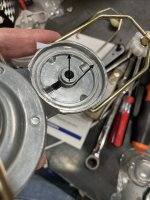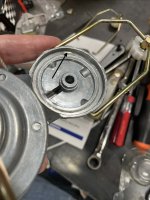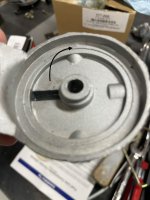KVH
Obi Wan
Offline
Trying to be helpful, in case anyone is dealing with fuel pump issues:
For the cheaper ones, my “guess” is that a new pump beats fixing it, especially with the known issues—variations in PSI, inferior screen and gasket, for a start. One thing is clear, to me at least: If you ever remove the fuel bowl on one of these cheaper pumps, you’d better have a “new” fresh bowl gasket handy, and you’d better install it with great care, and extremely tight. And if you see bubbles in the bowl, something isn’t right.
Love these cars. Fun playing and learning, and the learning never ends.
- I have three spare fuel pumps. If I remove the glass fuel bowls and gaskets, and then test the fit of the bowl to the pump housing, the imperfections are a bit alarming. On each I can wobble the bowl with a 1/16 inch teeter totter. See pics of high and low points where the bowl bobbles and rocks around.
- This tells me the glass bowl gasket isn’t just to assure a seal for minor imperfections or fluid escape, but, rather, it is absolutely necessary not only that a new gasket be used, not an old one, or reused one, but that that the bowl be installed extremely tight with a brand new gasket, using the plastic thumb nut—and that the bowl be examined to assure it is fixed and centered to the gasket for the full 360.
- This may sound like common sense, but I had three extra gaskets in my shop, and not a single one would seal the bowl in my pump. I had gas spilling onto my garage floor. I then took my three spare pumps and gaskets into a local shop and confirmed not only that there were material gaps and imperfections to be addressed, hopefully by the gasket, but that there appeared to be visible rises or depressions in the housing where the bowl is supposed to seat in the pump housing. See pics again below. Arrows point to imperfection areas.
- After a few hours of trying to seal my fuel bowl after removing it for inspection, first attempting to reuse the same gasket, then my spare gaskets (also used), I gave up and bought a new fuel pump. I’ve ordered new spare gaskets and filter screens, but I’ll just store for emergencies. The bowl in my new pump is secured extremely tight, so I dared not touch it.
- I installed my new pump and I have no leaks at the bowl. But that’s not the main point I wish to make. Aside from the critical importance of using new bowl gaskets and securing them extremely tight to account for, among other things, any pump housing imperfections, my new pump is exhibiting absolutely no air bubbles or surges like I was seeing last week. I other words, the air bubbles are gone. The problem was almost certainly internal to the pump, as my compression fittings are installed identically and were not then, nor now, leaking.
- In addition to eliminating the air bubbles, my new pump appears to be putting out more consistent PSI. My pressure gauge is no longer unpredictable. It reads right at 2.2 PSI. However, after initial installation it was excessively high, right about 2.9 which exceeds the Triumph spec of 1.25 to 2.5 PSI. Excessive pressure of course leads to flooding and fuel float failure.
For the cheaper ones, my “guess” is that a new pump beats fixing it, especially with the known issues—variations in PSI, inferior screen and gasket, for a start. One thing is clear, to me at least: If you ever remove the fuel bowl on one of these cheaper pumps, you’d better have a “new” fresh bowl gasket handy, and you’d better install it with great care, and extremely tight. And if you see bubbles in the bowl, something isn’t right.
Love these cars. Fun playing and learning, and the learning never ends.

 Hi Guest!
Hi Guest!

 smilie in place of the real @
smilie in place of the real @
 Pretty Please - add it to our Events forum(s) and add to the calendar! >>
Pretty Please - add it to our Events forum(s) and add to the calendar! >> 


